The Non-Destructive Testing of Architectural Heritage Surfaces via Machine Learning: A Case Study of Flat Tiles in the Jiangnan Region
Abstract
1. Introduction
1.1. Research Background
1.2. Literature Review
1.2.1. A Cultural and Conservation Study of Chinese Traditional Clay Roof Tiles
1.2.2. Application of Artificial Intelligence Technology in Architectural Heritage Inspection
1.2.3. Intelligent Management of Architectural Heritage Diseases
1.3. Problem Statement and Objectives
- (1)
- How many types of damage can be identified in the flat tiles on the heritage buildings in Cicheng Old Town based on site surveys and Unmanned Aerial Vehicle (UAV) photography?
- (2)
- What are the results of the photo-identification and analysis of the types of damage to flat tiles on the heritage buildings?
- (3)
- How effective is the trained machine learning model?
2. Materials and Methods
2.1. Flat Tiles in Cicheng Old Town
2.1.1. Characteristics of Chinese Flat Tiles
2.1.2. Types and Causative Factors of Damage to Flat Roof Tiles
- (1)
- Cracking: Flat tiles have a certain strength; however, long-term exposure to solar radiation, dry and wet cycles, and freeze–thaw cycles makes them susceptible to weathering. Weathering damage generally develops from the surface to the interior, and cracks naturally appear in aged shingles or easily develop under the action of external forces. Rainwater can seep into the cracks and remain there for long periods, causing the shingles to become weaker.
- (2)
- Breakage: If cracked tiles are not repaired, they may break under natural aggression or external forces. Larger broken sections will not be able to serve as a roof barrier, and rainwater will leak into the shedthin tiles or shedthin boards covering the underside of the flat tiles or, in severe cases, into the roof rafters or directly leak into the interior.
- (3)
- Lichen Growth: A lichen is a composite organism formed by the symbiotic association of algae or cyanobacteria with filaments of various fungal species. The clay material making up the flat tiles, combined with the moist environment, facilitates the growth of lichens on the tile surfaces. Lichens are symbiotic complexes of algae and fungi whose root systems can penetrate the building material, leading to the deterioration of the tiles. Lichens can also reduce the water resistance of flat tiles, widen cracks, and increase the risk of water leakage. They also affect the esthetics of ancient buildings.
- (4)
- Leaf Accumulation: The construction of ancient Chinese buildings emphasized integration with nature, and tall trees were often planted on the sides of the buildings. Leaves from the trees fall directly onto or are blown by the wind onto the roof; if these are not cleaned up in time, large quantities of leaves will block the drain of the base tiles, preventing the quick drainage of rainwater and causing the roof to be in a long-term wet state, thus increasing the load bearing capacity of the tiles and making them prone to breakage.
- (5)
- Vegetation Growth: The long-term accumulation of fallen leaves provides soil and nutrients for seed growth, which, together with good exposure to sunlight, makes it easy for a large number of succulent plants or small tares to grow. The growth of plants will accelerate the breakage of tiles, and the increased weight of the roof due to the growing plants will deform the roof structure, thus affecting the safety of the whole ancient building.
2.2. Research Process
- (1)
- Determination of the collection area. The samples used in this study were collected from the buildings in Feng’s Color Decorated Courtyard, Qian Zhao’s Residence, and Confucian Temple in Cicheng Old Town (Figure 7). These three buildings are all National Key Cultural Relic Protection units, and the roofing materials on these buildings are typical representatives of roofing in the Jiangnan region.
- (2)
- Drone aerial image acquisition. To establish an effective model for identifying the types of damage to flat tile roofs, the diversity and representativeness of the data are directly correlated with the stability and generalization of the model. The research team collected field data on 19 December 2024 and 26 December 2024. During the fieldwork, the roofs were photographed in flight using a DJI drone (Mavic 3E, Shenzhen Dajiang Innovation Technology Co., Ltd., Shenzhen, China); the drone was flown 2–5 m above the roofs to obtain high-quality tile surface image data. Sample collection sites were chosen on the roofs of buildings with obvious damage features and good lighting to ensure the clarity of the photographs. A total of 412 sample photos were taken of the site, and 351 flat tile roof images were obtained after screening the samples for machine learning training. The collected data reflected the characteristics of various damage types, including 87 images of breakage, 87 images of cracking, 89 images of leaf accumulation, and 88 images of lichen growth. The diversity of the data comes not only from the differences in tile damage types but also from the multiple dimensions of damage severity, size, shape, and color.
- (3)
- Data unification. A series of image preprocessing methods was used in the data processing stage to optimize image quality and ensure consistency of data input, thereby improving model training. These include histogram equalization and noise filtering techniques. The purpose of this step is to eliminate the influence of environmental factors such as light and shadow, reduce random noise, and improve the clarity of damaged features in the image. Additionally, this study performed image size standardization to ensure that all images fed into the YOLOv8 model had the same resolution and dimensions. Image size standardization involved adjusting all images to a unified 512 × 512-pixel resolution, 96 dpi (dots per inch) for both horizontal and vertical resolutions, and 24 bits for depth. This goal was achieved by combining resizing and mosaicking, in which an overlapping strategy was used in the mosaicking process to ensure that complete thin-sheet features existed in at least one image. This step ensures the stability of model training and reduces the computational complexity caused by inconsistent image sizes and scales. Finally, during the training stage of the model, codes for data augmentation operations such as rotating and flipping images were added to expand the diversity of the dataset and enhance the versatility and robustness of the model.
- (4)
- Data labeling. To ensure that the YOLOv8 model can accurately identify the type of damage and spatial location of roof tiles, the research team performed high-quality manual annotation work on all collected images. The open-source image annotation tool LabelImg (https://github.com/HumanSignal/labelImg, accessed on 16 January 2025) was used for the annotation process to clarify the boundaries and attributes of each type of damaged area by drawing precise bounding boxes in the image. During the annotation process, each type of tile surface damage (such as fracture, crack, leaf accumulation, or lichen growth) was assigned a unique category code and was strictly boxed and named according to the category definition to establish a clear image and label mapping relationship. To further improve the data quality and the transferability of the model, the annotation work was reviewed and calibrated twice after the first draft was completed. The first round of annotations was completed by the first author of this study; she also verified the content of her work. In the second round, the second author of this study conducted a final review of the key samples to minimize human errors and ensure the accuracy of the annotation labels in terms of semantics and shape boundaries.
- (5)
- YOLOv8 model training. After the image data were labeled, the research team systematically trained the task of identifying roof tile damage based on the YOLOv8 model architecture. As an advanced single-stage model in the field of target detection, YOLOv8 has both accuracy and speed advantages, and its stability has been verified in multiple scenarios. This study first loaded the pre-trained YOLOv8 model as the basis and adopted a frozen training strategy at the beginning of training to retain the existing general feature extraction capabilities of the backbone. In the first 50 training epochs, only the head was trained, and some parameters of the backbone were kept constant to prevent the model from overfitting small sample data in the initial stage. Starting from the 51st epoch, we began full training by gradually allowing all model parameters to be adjusted, and we continued this training until the 300th epoch to thoroughly investigate how deep features and boundary features relate to different categories. During the training process, the input image was uniformly adjusted to a fixed size of 512 × 512 pixels. The SGD optimizer was used during the training process. The initial learning rate was set to 0.01, and the minimum learning rate was set to 0.0001. Cosine decay was introduced to adjust the learning rate dynamically to achieve smooth convergence. The momentum parameter was set to 0.937, the batch size in the freezing phase to 4, and the batch size in the thawing phase was adjusted to 2 to adapt to the training memory load. The training set contained 351 annotated images, while the number of validation sets was 40.
- (6)
- Model testing. To systematically evaluate the actual performance of the YOLOv8 model in the flat tile damage detection task after completing the model training, this study designed a set of multi-index comprehensive evaluation systems. In the test phase, instead of using a single indicator as the judgment standard, this study combined indicators such as average precision (AP), F1, precision, recall, and log-average miss rate (LAMR) to measure the detection performance of the model from different dimensions. Among them, AP is used to evaluate the average recognition accuracy of the model under different confidence thresholds, reflecting its overall target recognition ability; the F1 score takes into account both precision and recall and strikes a balance between accuracy and detection rate, which is a key indicator for measuring the robustness of the model; and LAMR is suitable for measuring the stability of the detection system under multi-scale and multi-background conditions by taking a logarithmic weighted average of the recall level under different missed detection rates, especially for the recognition ability of low-visibility targets. Additionally, to better understand the model’s classification ability, this study constructed a confusion matrix, which shows the clarity and confusability of the classification boundaries among various types of damage and helps identify potential recognition error trends in the model. In addition to quantitative indicators, the testing phase also included a comparative analysis of visual detection results and feature heatmaps. Heatmaps display how much focus the model gives to different parts of an image at various levels, which helps us understand how the model reacts to fine details, edges, and blocked areas. By looking at the detection results alongside manual notes on the layout and categories, we can check whether the model’s predictions match the actual data and also identify where it struggles to recognize complex flat tile surfaces.
- (7)
- Result analysis. After completing model training and multidimensional performance testing, this study further selected the YOLOv8 model with the best performance in the training set and validation set and applied it to new image data collected in the field to verify the recognition ability and robustness of the model in unknown environments. The test images included photographs of flat tile roofs taken under multiple real-life scenarios, covering different lighting conditions, perspective changes, and complex background interference, in order to ensure they were as close as possible to the application scenarios in real architectural heritage inspection tasks. During the model reasoning process, the research team concentrated on recognizing various types of damage in real environments, particularly emphasizing the recognition performance of categories that experience significant interference from natural factors such as lichen growth and fallen leaves, particularly under conditions of high occlusion or low contrast.
2.3. Model Structure Design
3. Results
3.1. Training Process
3.2. Comparison of Indicators
3.3. Comparative Analysis of Model Detection Results
4. Discussion
5. Conclusions
Author Contributions
Funding
Institutional Review Board Statement
Informed Consent Statement
Data Availability Statement
Acknowledgments
Conflicts of Interest
References
- Winners of 2009 UNESCO Asia-Pacific Awards for Cultural Heritage Conservation. 2009. Available online: https://www.unesco.org/en/articles/winners-heritageawards (accessed on 10 May 2025).
- Knapp, R.G. Chinese Houses: The Architectural Heritage of a Nation; Tuttle Publishing: North Clarendon, VT, USA, 2012. [Google Scholar]
- Xu, M. Study on History of Little Black Tile in China. J. Chin. Cult. 2014, 4, 86–91. [Google Scholar]
- Bown, M.; Miller, K. The use of unmanned aerial vehicles for sloped roof inspections–considerations and constraints. J. Facil. Manag. Educ. Res. 2018, 2, 12–18. [Google Scholar] [CrossRef] [PubMed]
- Wei, C. Endless Sights of Tiled Buildings: A Discussion of the Association Between the Developments of the Tiled Roofs and the Wooden Structures System. Archit. J. 2019, 12, 20–27. [Google Scholar]
- Jiazhi, L. Influence of “Qin Brick and Han Tile” in History. J. Build. Mater. 1998, 1, 26–29. [Google Scholar]
- Ahn, K.; Han, M.S. Characteristic classification using physicochemical analysis data of ancient roof tiles. J. Radioanal. Nucl. Chem. 2023, 332, 5289–5298. [Google Scholar] [CrossRef]
- Sharon, W.W.Y.; Darith, E.; Rachna, C.; Suy, T.B. Two traditions: A comparison of roof tile manufacture and usage in Angkor and China. Asian Perspect. 2021, 60, 128–156. Available online: https://www.jstor.org/stable/27136713 (accessed on 12 May 2025). [CrossRef]
- Cuilin, L. Construction and Craftsmanship of Tile Roofing in Jiang-Zhe Area. Master’s Thesis, Southeast University, Nanjing, China, 2016. [Google Scholar]
- Chen, Y. An ‘Anthropo-Architectural Approach’ to Integrated Conservation: A Case Study of Cultural Heritage Associated with the Traditional Chinese Roof Tile Industry, in School of Architecture, Design and Planning. Ph.D. Thesis, The University of Queensland, Brisbane, Australia, 2024. Available online: https://espace.library.uq.edu.au/view/UQ:435e694 (accessed on 10 May 2025).
- Yong, L. Research on the Brick and Tile Craftsmanship of Huizhou Traditional Residence in the Ming and Qing Dynasties, in School of Architeture and Urban Planning. Master’s Thesis, Anhui Jianzhu University, Hefei, China, 2023. [Google Scholar]
- Guo, Q. Tile and Brick Making in China: A Study of the “Yingzao Fashi”. Constr. Hist. 2000, 16, 3–11. [Google Scholar]
- Yang, W.; Wen, X. Antique blue brick and fired common brick on the quality of the research. China Build. Mater. Sci. Technol. 2017, 26, 20–22. [Google Scholar]
- Zhao, P.; Zhang, X.; Qin, L.; Zhang, Y.; Zhou, L. Conservation of disappearing traditional manufacturing process for Chinese grey brick: Field survey and laboratory study. Constr. Build. Mater. 2019, 212, 531–540. [Google Scholar] [CrossRef]
- Peng, Z. Deterioration Mechanism of Grey Brick and Masonry Structures Under the Action of Load and Environment in Materials Science and Engineering School. Ph.D. Thesis, Southeast University, Nanjing, China, 2015. [Google Scholar]
- Dai, S.; Huang, J.; Shen, Z.; Zhou, Y.; Ju, F. Characteristics of Historic Roof tiles and Proposed Technical Standard for Restoration of traditional architecture in the Southern Shanxi Province, China. In Proceedings of the 2014 Conference on Architectural Historian Studies of China, Fuzhou, China, 18 October 2014. [Google Scholar]
- Bi, S.; Du, J.; Tian, Z.; Zhang, Y. Investigating the spatial distribution mechanisms of traditional villages from the human geography region: A case study of Jiangnan, China. Ecol. Inform. 2024, 81, 102649. [Google Scholar] [CrossRef]
- Zheng, L.; Chen, Y.; Yan, L.; Zhang, Y. Automatic detection and recognition method of Chinese clay tiles based on YOLOv4: A case study in Macau. Int. J. Archit. Herit. 2024, 18, 1551–1570. [Google Scholar] [CrossRef]
- Yang, X.; Zheng, L.; Chen, Y.; Feng, J.; Zheng, J. Recognition of Damage Types of Chinese Gray-Brick Ancient Buildings Based on Machine Learning—Taking the Macau World Heritage Buffer Zone as an Example. Atmosphere 2023, 14, 346. [Google Scholar] [CrossRef]
- Hao, Y.; Yao, Z.; Wu, R.; Bao, Y. Damage and restoration technology of historic buildings of brick and wood structures: A review. Herit. Sci. 2024, 12, 301. [Google Scholar] [CrossRef]
- Llamas, J.; Lerones, M.P.; Medina, R.; Zalama, E.; Gómez-García-Bermejo, J. Classification of Architectural Heritage Images Using Deep Learning Techniques. Appl. Sci. 2017, 7, 992. [Google Scholar] [CrossRef]
- Solla, M.; Maté-González, M.Á.; Blázquez, C.S.; Lagüela-López, S.; Nieto, I.M. Analysis of structural integrity through the combination of non-destructive testing techniques in heritage inspections: The study case of San Segundo’s hermitage (Ávila, Spain). J. Build. Eng. 2024, 89, 109295. [Google Scholar] [CrossRef]
- Akinosho, T.D.; Oyedele, L.O.; Bilal, M.; Ajayi, A.O.; Delgado, M.D.; Akinade, O.O.; Ahmed, A.A. Deep learning in the construction industry: A review of present status and future innovations. J. Build. Eng. 2020, 32, 101827. [Google Scholar] [CrossRef]
- Yan, L.; Chen, Y.; Zheng, L.; Zhang, Y. Application of computer vision technology in surface damage detection and analysis of shedthin tiles in China: A case study of the classical gardens of Suzhou. Herit. Sci. 2024, 12, 72. [Google Scholar] [CrossRef]
- Wang, N.; Zhao, X.; Zhao, P.; Zhang, Y.; Zou, Z.; Ou, J. Automatic damage detection of historic masonry buildings based on mobile deep learning. Autom. Constr. 2019, 103, 53–66. [Google Scholar] [CrossRef]
- Ravichand, M.; Kumar, R.; Hazela, B.; Suthar, T. Crack on brick wall detection by computer vision using machine learning. In Proceedings of the 2022 6th International Conference on Electronics, Communication and Aerospace Technology, Coimbatore, India, 1–3 December 2022; IEEE: Danvers, MA, USA, 2022; pp. 1017–1020. [Google Scholar] [CrossRef]
- Wang, N.; Zhao, X.; Zou, Z.; Zhao, P.; Qi, F. Autonomous damage segmentation and measurement of glazed tiles in historic buildings via deep learning. Comput.-Aided Civ. Infrastruct. Eng. 2020, 35, 277–291. [Google Scholar] [CrossRef]
- Xu, J.; Zeng, F.; Liu, W.; Takahashi, T. Damage Detection and Level Classification of Roof Damage after Typhoon Faxai Based on Aerial Photos and Deep Learning. Appl. Sci. 2022, 12, 4912. [Google Scholar] [CrossRef]
- Diwan, T.; Anirudh, G.; Tembhurne, J.V. Object detection using YOLO: Challenges, architectural successors, datasets and applications. Multimed. Tools Appl. 2023, 82, 9243–9275. [Google Scholar] [CrossRef] [PubMed]
- Terven, J.; Córdova-Esparza, D.-M.; Romero-González, J.-A. A Comprehensive Review of YOLO Architectures in Computer Vision: From YOLOv1 to YOLOv8 and YOLO-NAS. Mach. Learn. Knowl. Extr. 2023, 5, 1680–1716. [Google Scholar] [CrossRef]
- Sohan, M.; Ram, T.S.; Reddy, C.V.R. A review on yolov8 and its advancements. In Data Intelligence and Cognitive Informatics; Jacob, I.J., Piramuthu, S., Falkowski-Gilski, P., Eds.; ICDICI 2023; Algorithms for Intelligent Systems; Springer: Singapore, 2023. [Google Scholar] [CrossRef]
- Qiu, H.; Zhang, J.; Zhuo, L.; Xiao, Q.; Chen, Z.; Tian, H. Research on intelligent monitoring technology for roof damage of traditional Chinese residential buildings based on improved YOLOv8: Taking ancient villages in southern Fujian as an example. Herit. Sci. 2024, 12, 231. [Google Scholar] [CrossRef]
- Gao, C.; Zhang, Q.; Tan, Z.; Zhao, G.; Gao, S.; Kim, E.; Shen, T. Applying optimized YOLOv8 for heritage conservation: Enhanced object detection in Jiangnan traditional private gardens. Herit. Sci. 2024, 12, 31. [Google Scholar] [CrossRef]
- Colucci, E.; Iacono, E.; Matrone, F.; Ventura, G.M. The development of a 2D/3D BIM-GIS web platform for planned maintenance of built and cultural heritage: The MAIN10ANCE project. Int. Arch. Photogramm. Remote Sens. Spat. Inf. Sci. 2023, 48, 433–439. [Google Scholar] [CrossRef]
- Vacca, G.; Quaquero, E.; Pili, D.; Brandolini, M. GIS-HBIM integration for the management of historical buildings. Int. Arch. Photogramm. Remote Sens. Spat. Inf. Sci. 2018, 42, 1129–1135. [Google Scholar] [CrossRef]
- Ávila, F.; Blanca-Hoyos, Á.; Puertas, E.; Gallego, R. HBIM: Background, Current Trends, and Future Prospects. Appl. Sci. 2024, 14, 11191. [Google Scholar] [CrossRef]
- Rolim, R.; López-González, C.; Viñals, M.J. Analysis of the Current Status of Sensors and HBIM Integration: A Review Based on Bibliometric Analysis. Heritage 2024, 7, 2071–2087. [Google Scholar] [CrossRef]
- Murphy, M.; McGovern, E.; Pavia, S. Historic building information modelling (HBIM). Struct. Surv. 2009, 27, 311–327. [Google Scholar] [CrossRef]
- Lovell, L.J.; Davies, R.J.; Hunt, D.V.L. The Application of Historic Building Information Modelling (HBIM) to Cultural Heritage: A Review. Heritage 2023, 6, 6691–6717. [Google Scholar] [CrossRef]
- Mol, A.; Cabaleiro, M.; Sousa, H.S.; Branco, J.M. HBIM for storing life-cycle data regarding decay and damage in existing timber structures. Autom. Constr. 2020, 117, 103262. [Google Scholar] [CrossRef]
- Dionizio, R.F.; Dezen-Kempter, E. From Data and Metadata to HBIM-GIS Integration. Int. J. Archit. Herit. 2024, 1–14. [Google Scholar] [CrossRef]
- Li, Q.; Zhang, T.; Fang, Y.; Lin, F. A Pathological Diagnostic Method for Traditional Brick-Masonry Dwellings: A Case Study in Guangfu Ancient City. Buildings 2024, 14, 3563. [Google Scholar] [CrossRef]
- Liu, S.; Wang, R.; Yu, J.; Peng, X.; Cai, Y.; Tu, B. Effectiveness of the anti-erosion of an MICP coating on the surfaces of ancient clay roof tiles. Constr. Build. Mater. 2020, 243, 118202. [Google Scholar] [CrossRef]

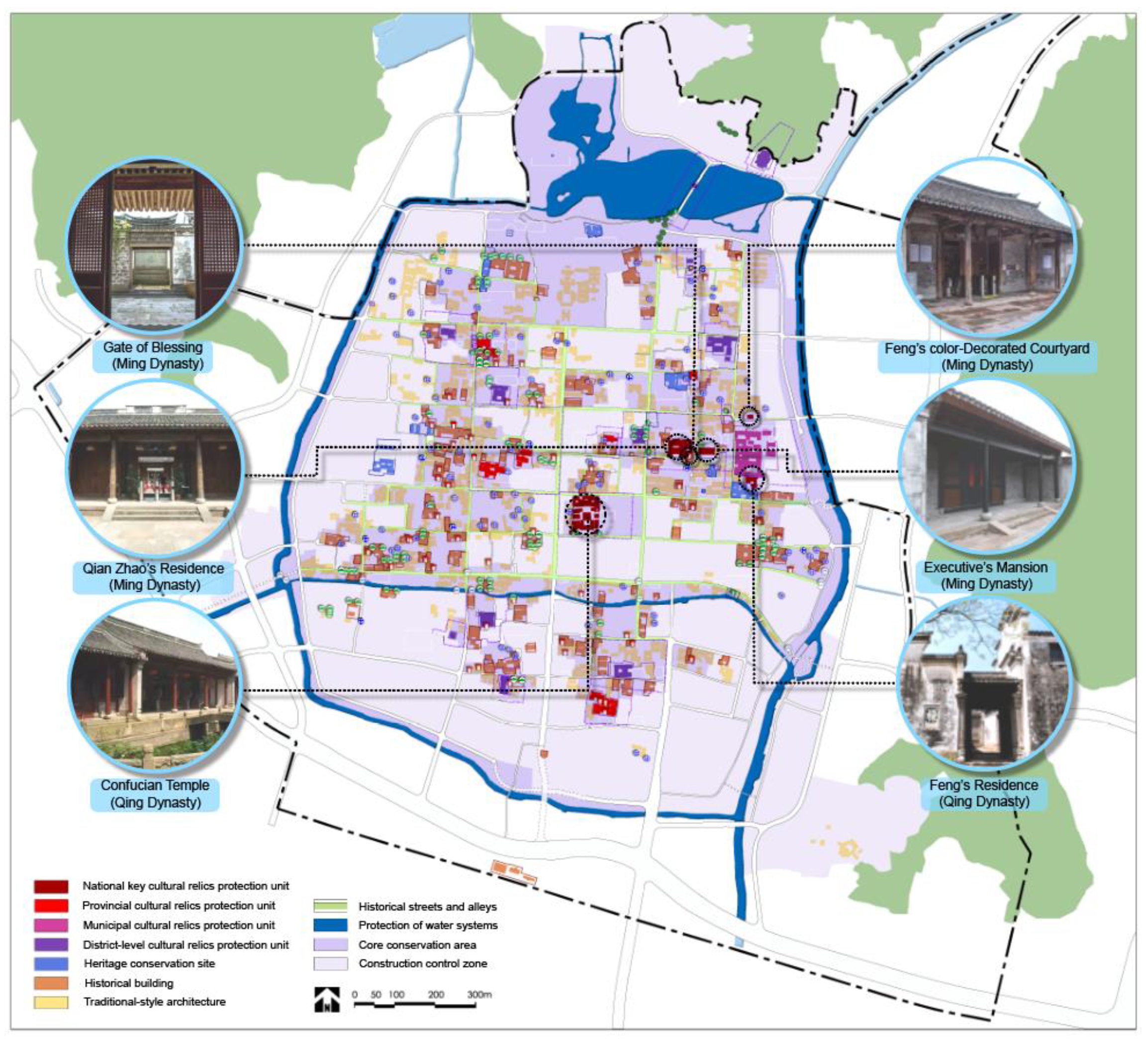
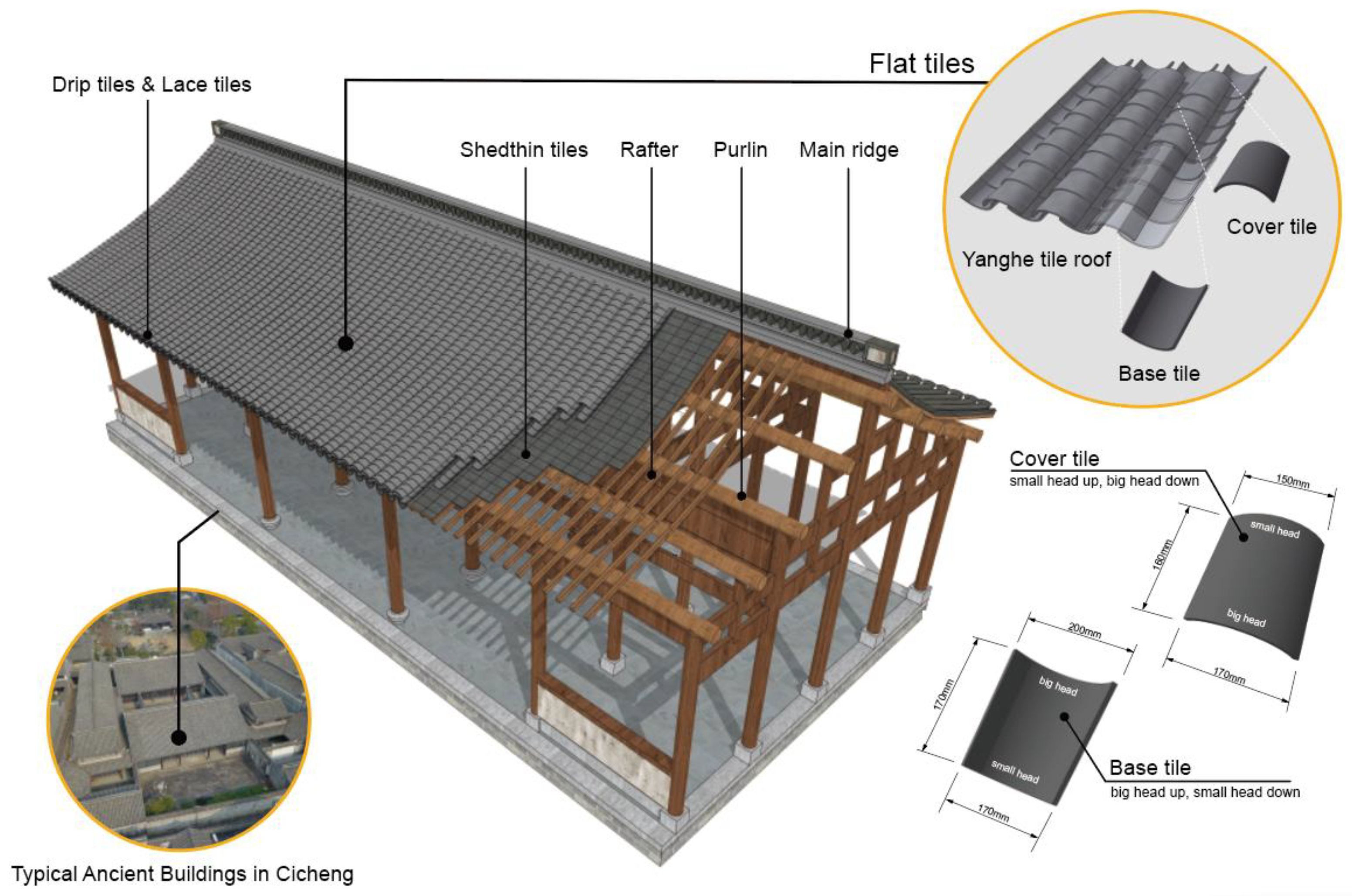

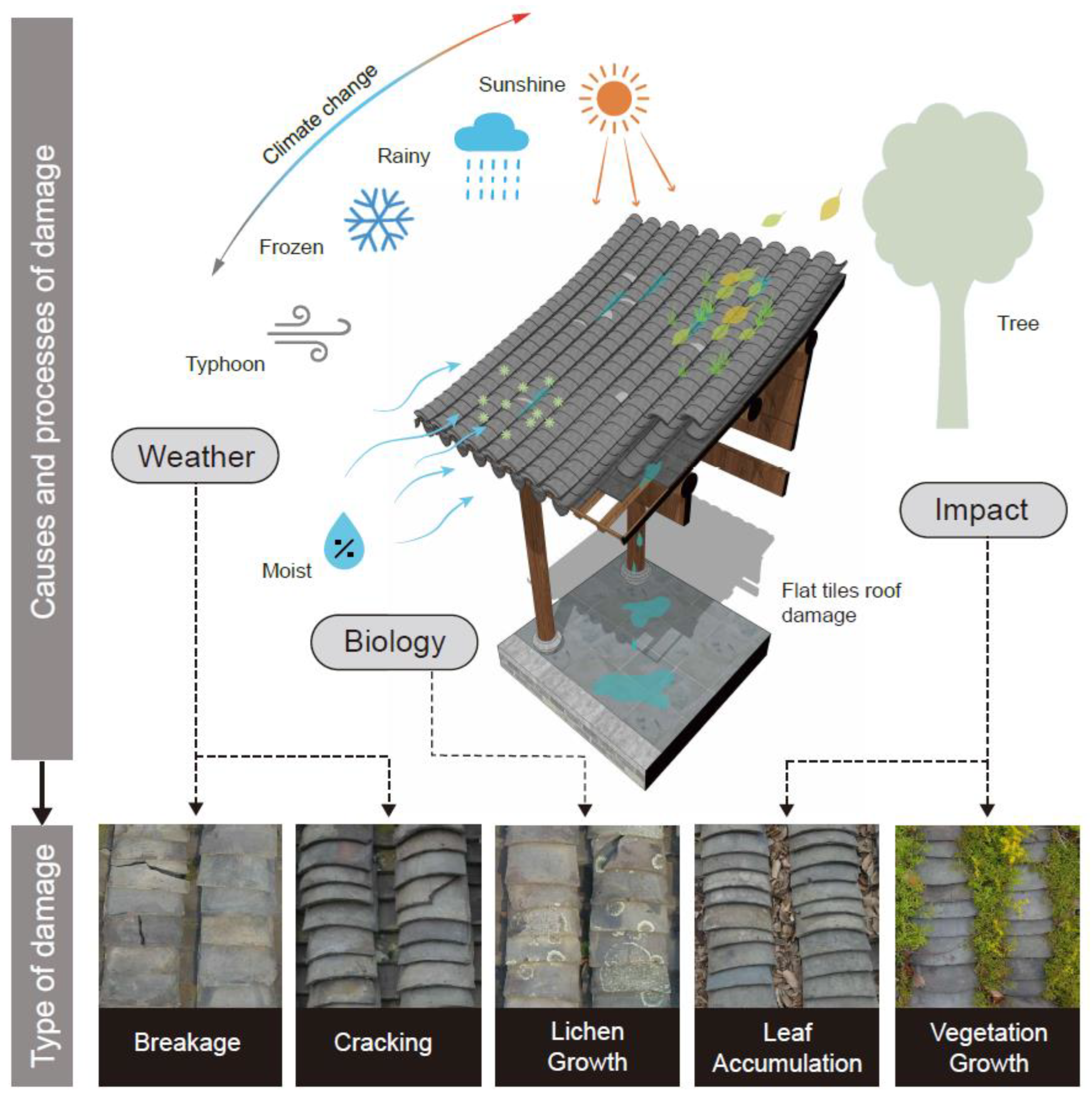
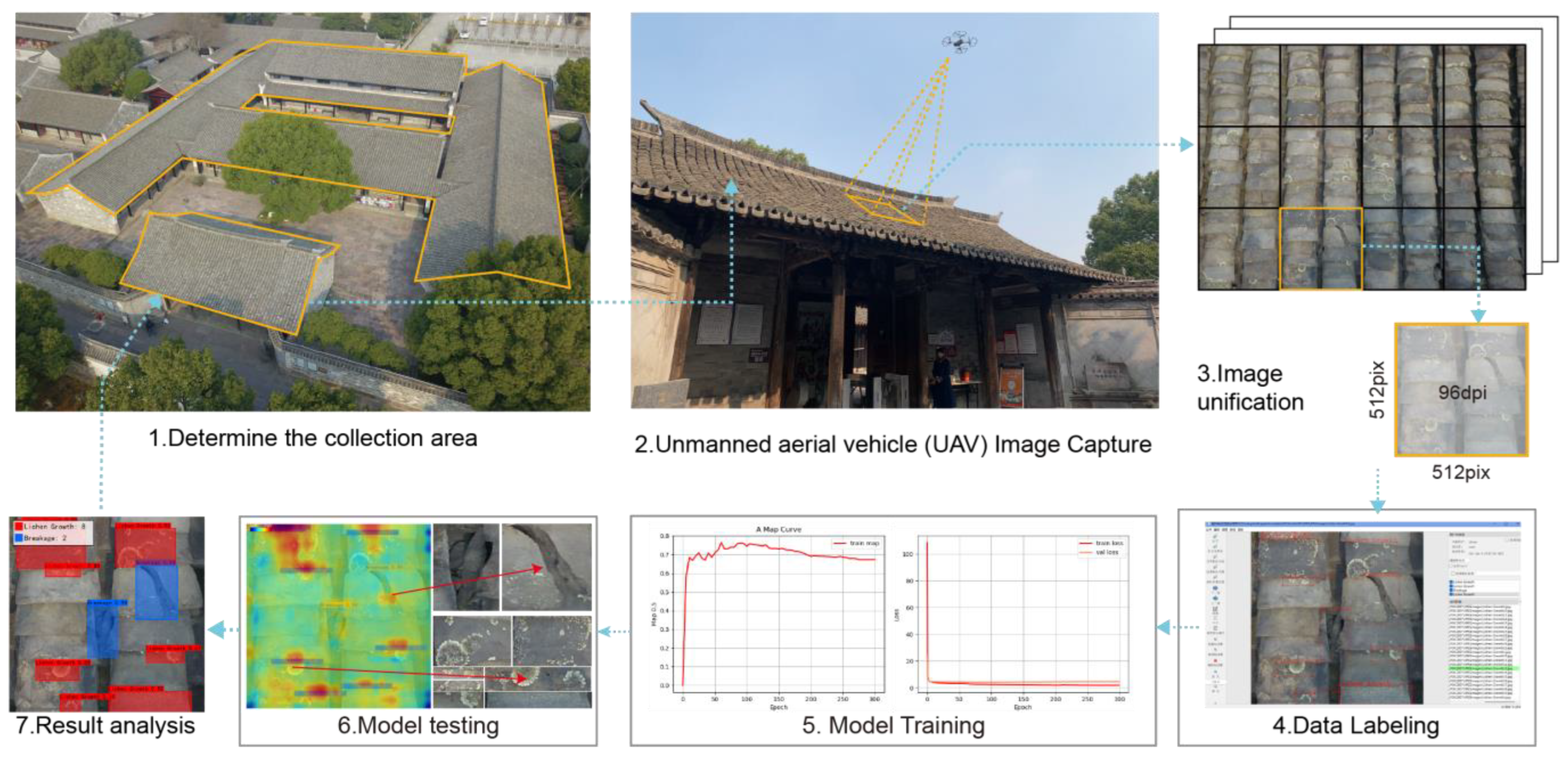

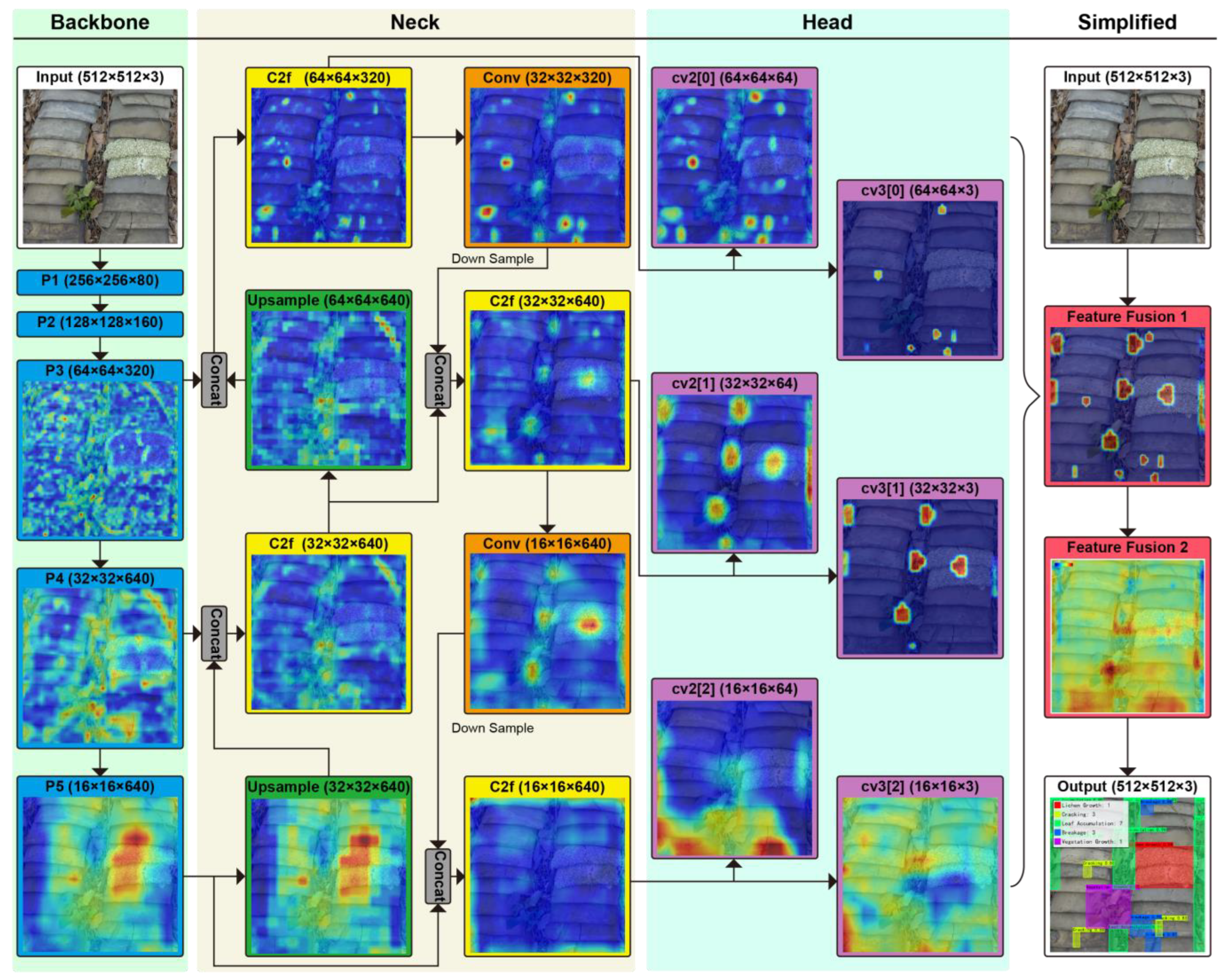
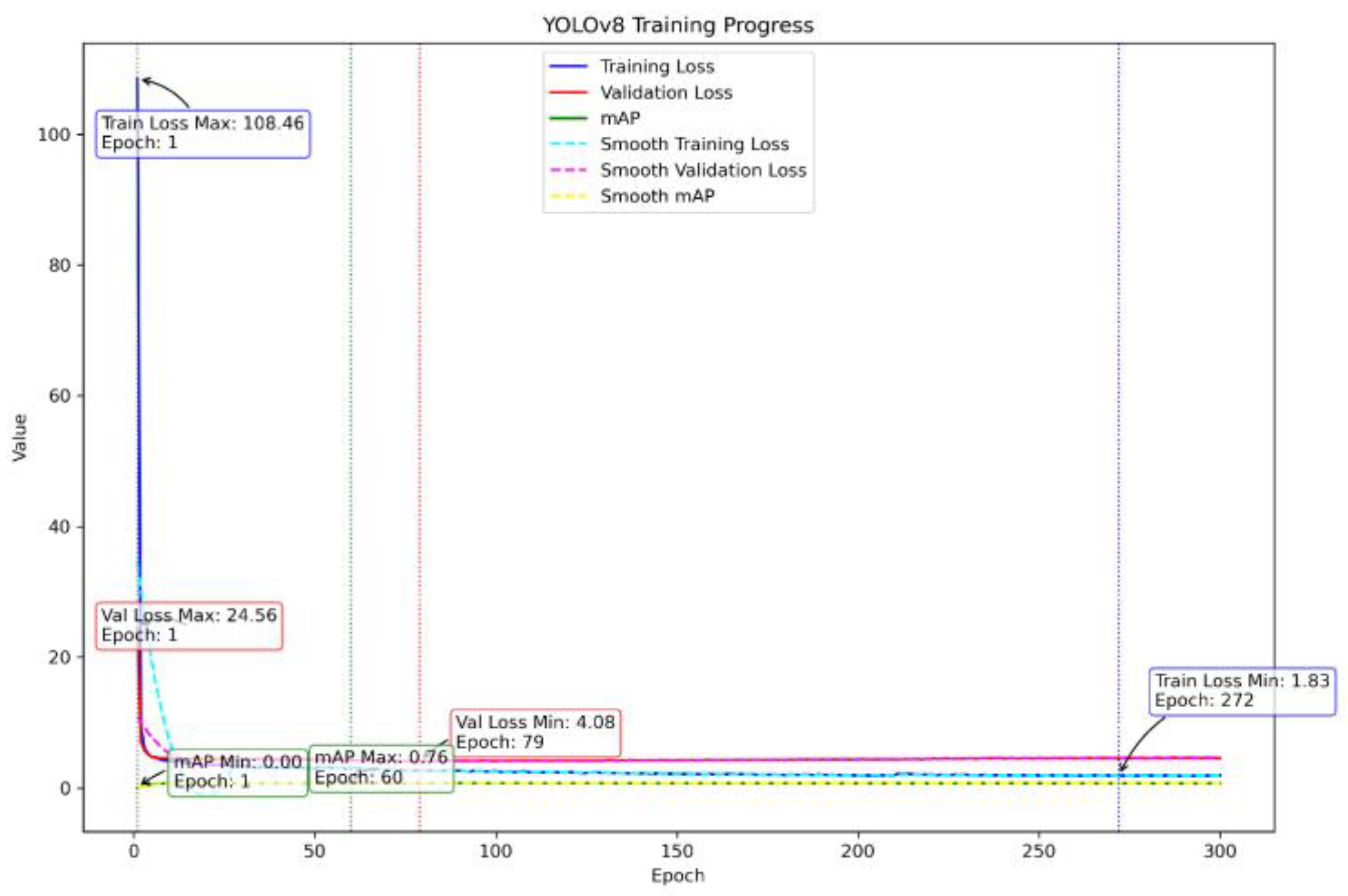
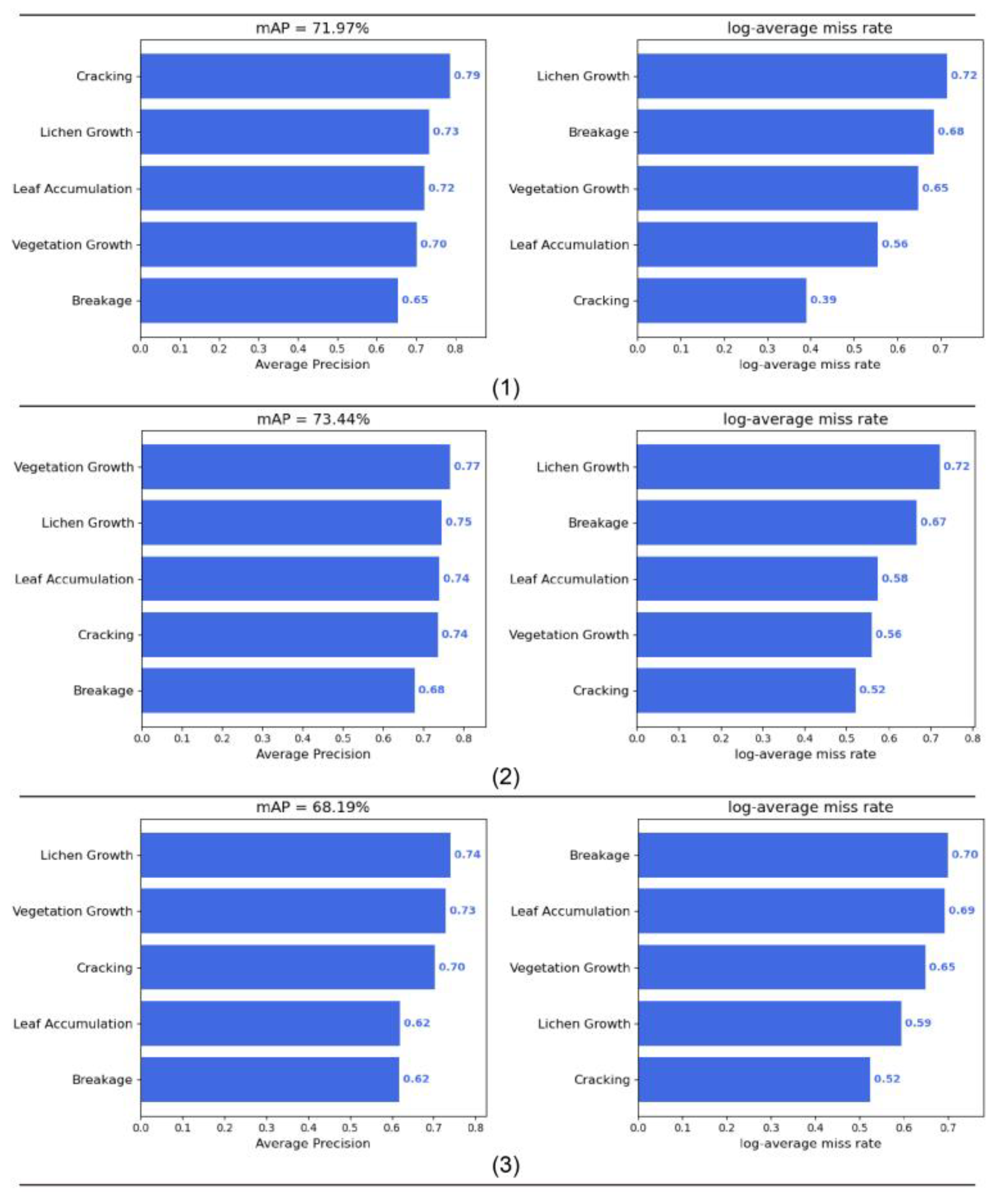

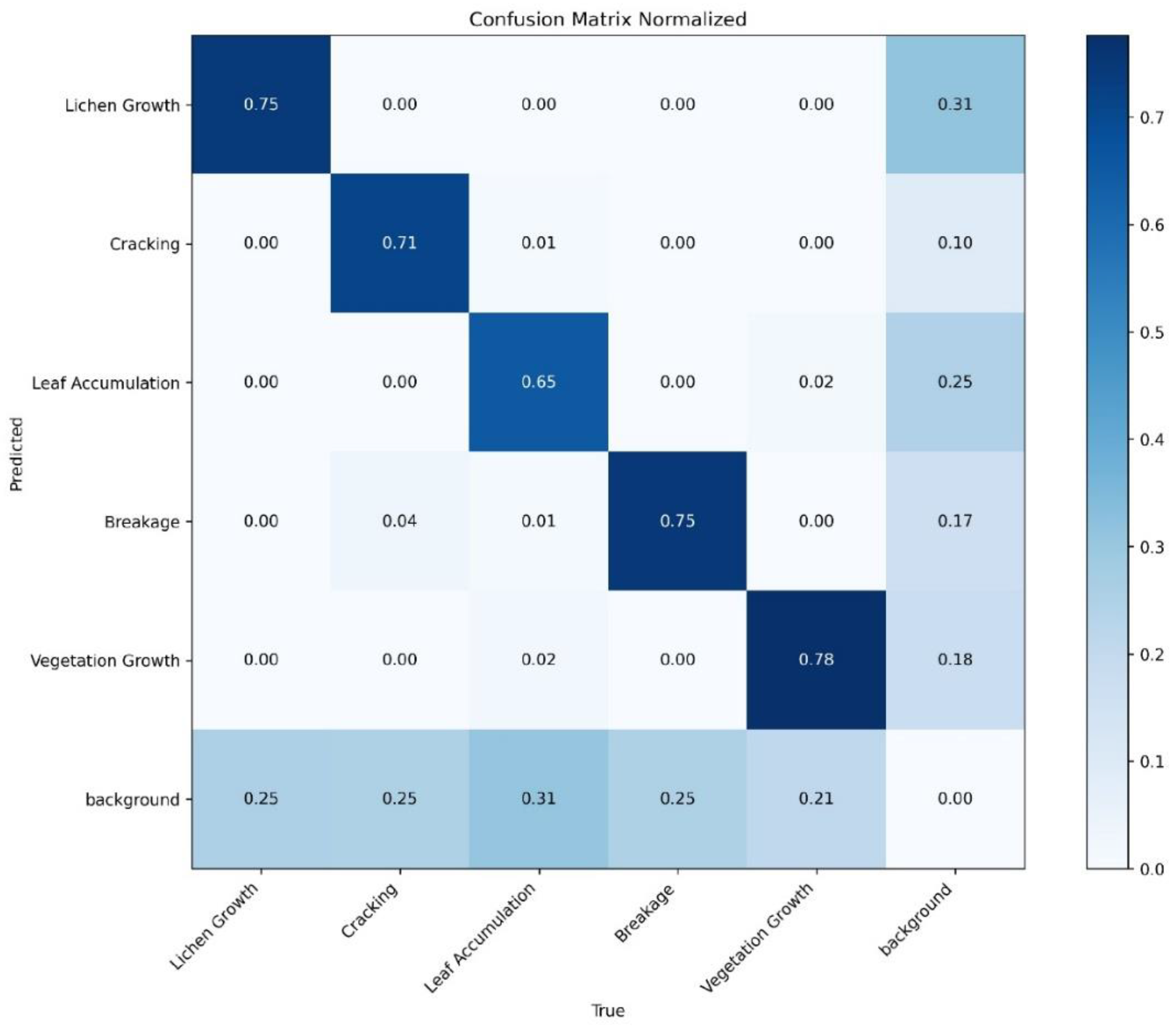
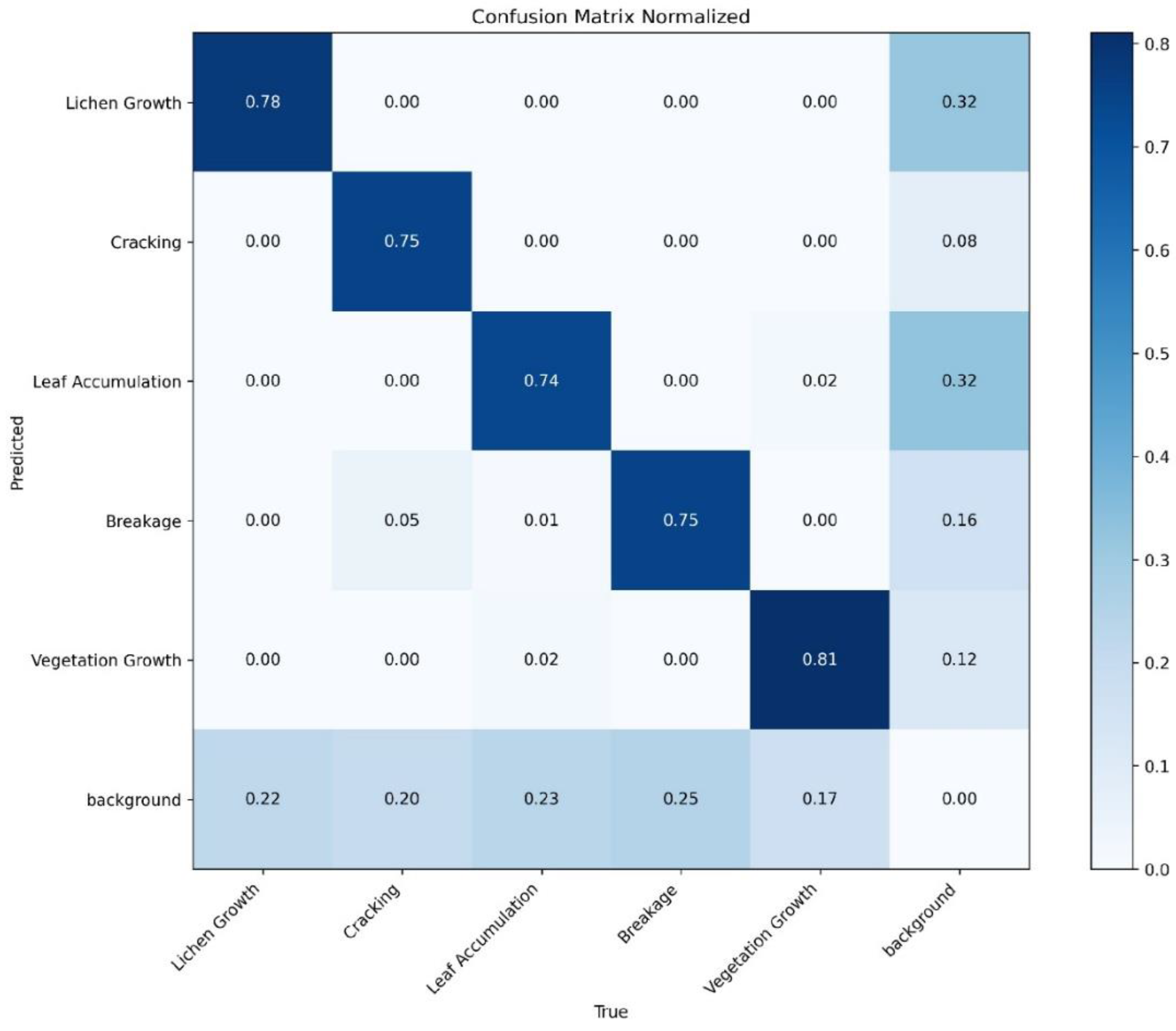
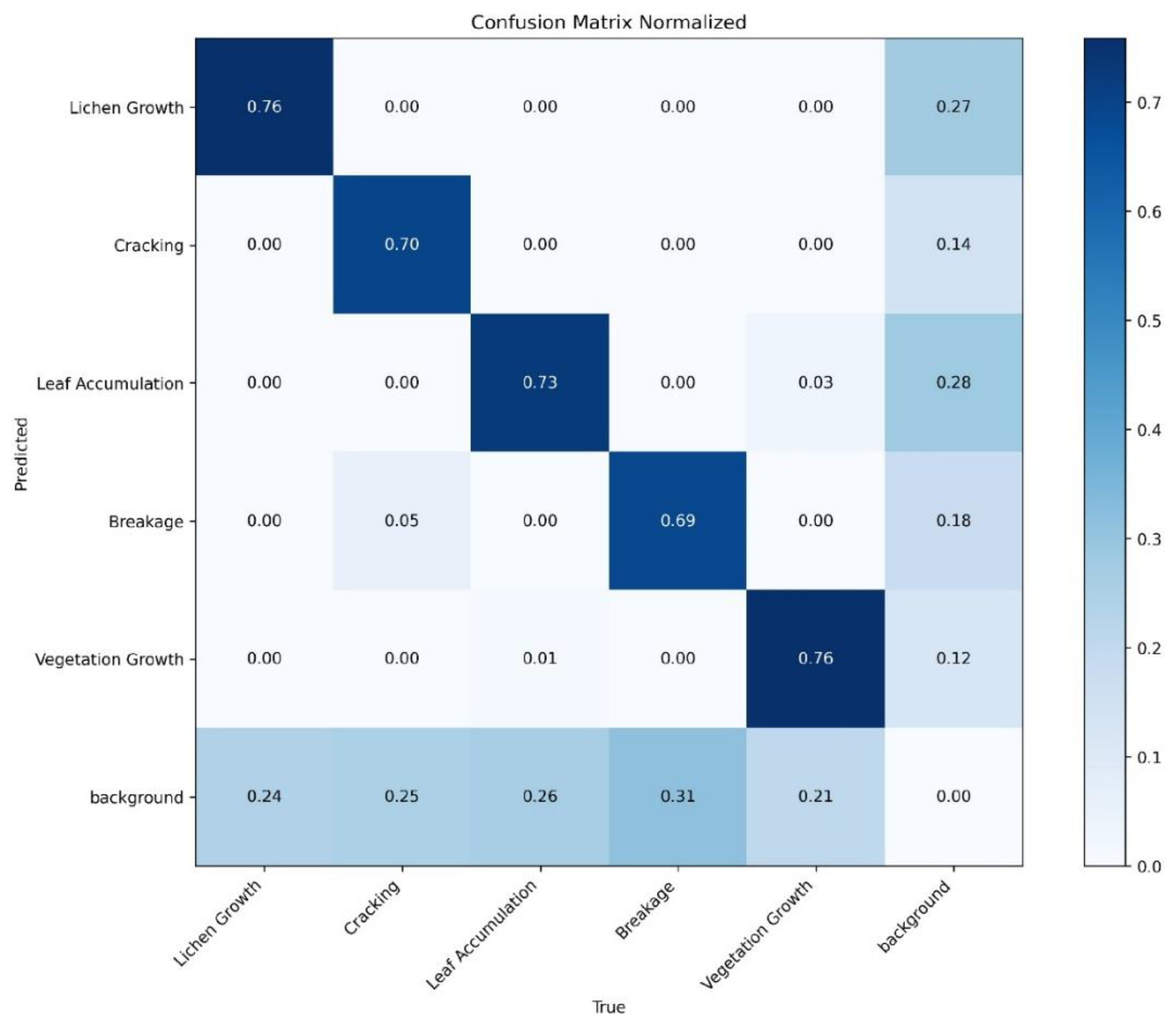
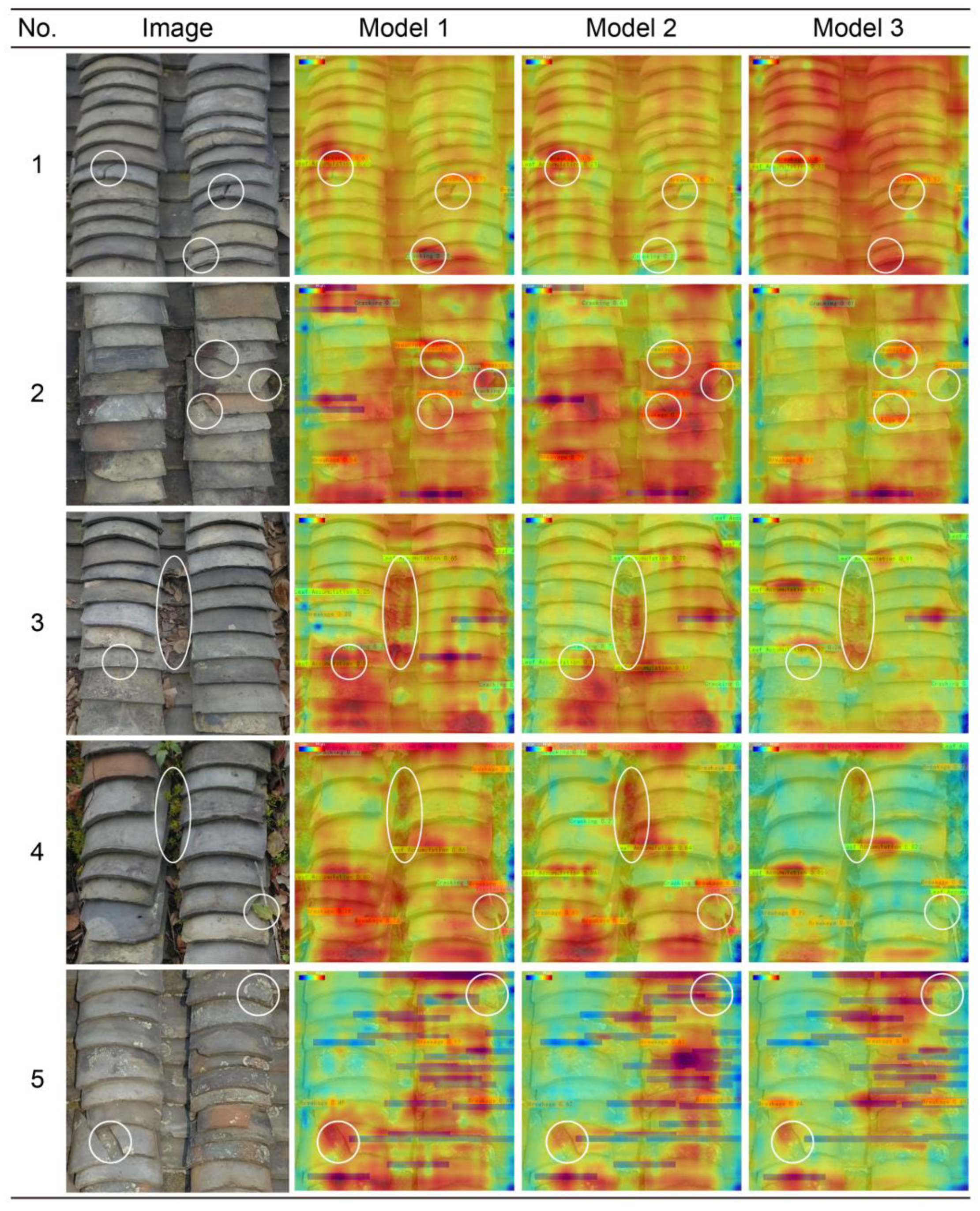
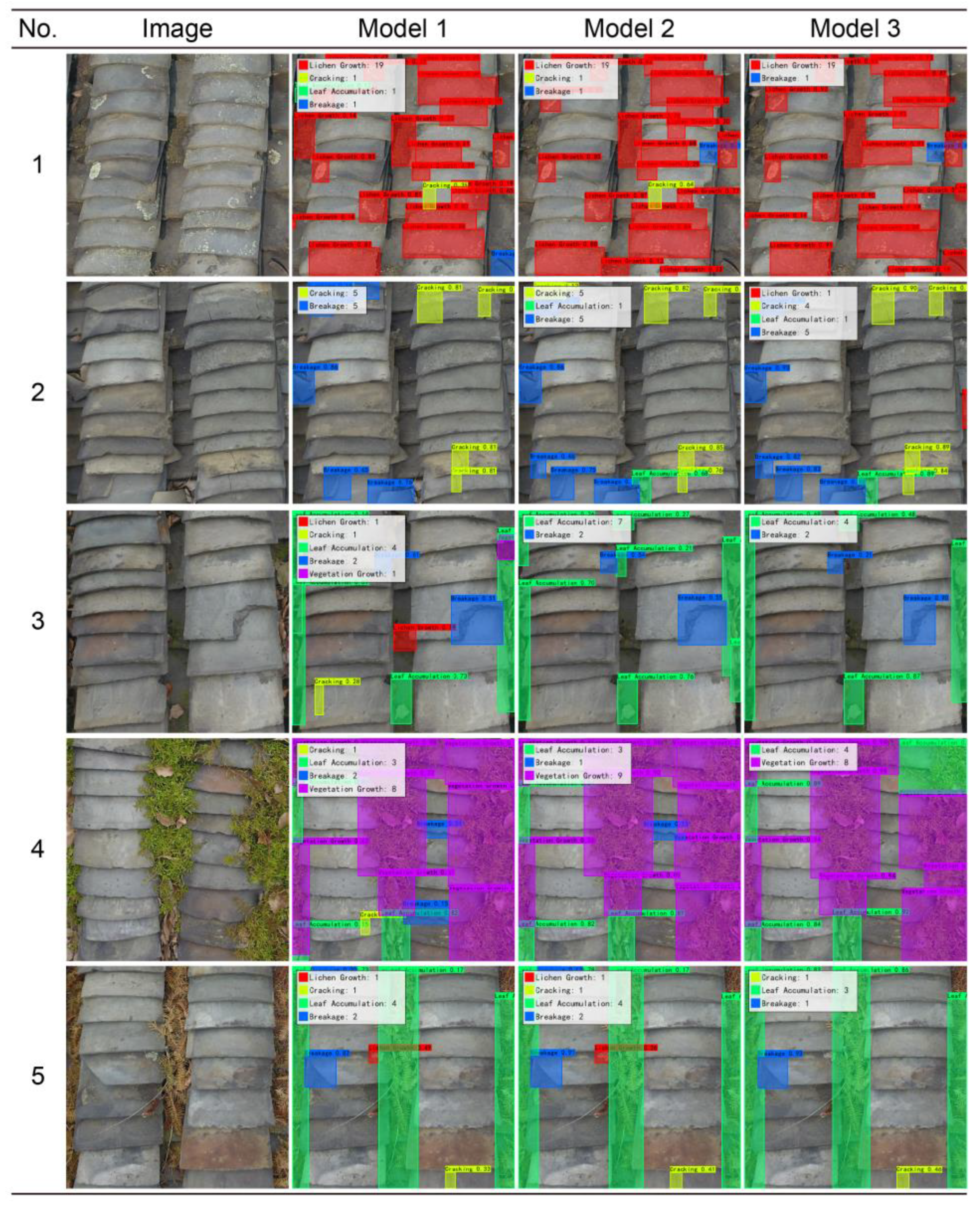

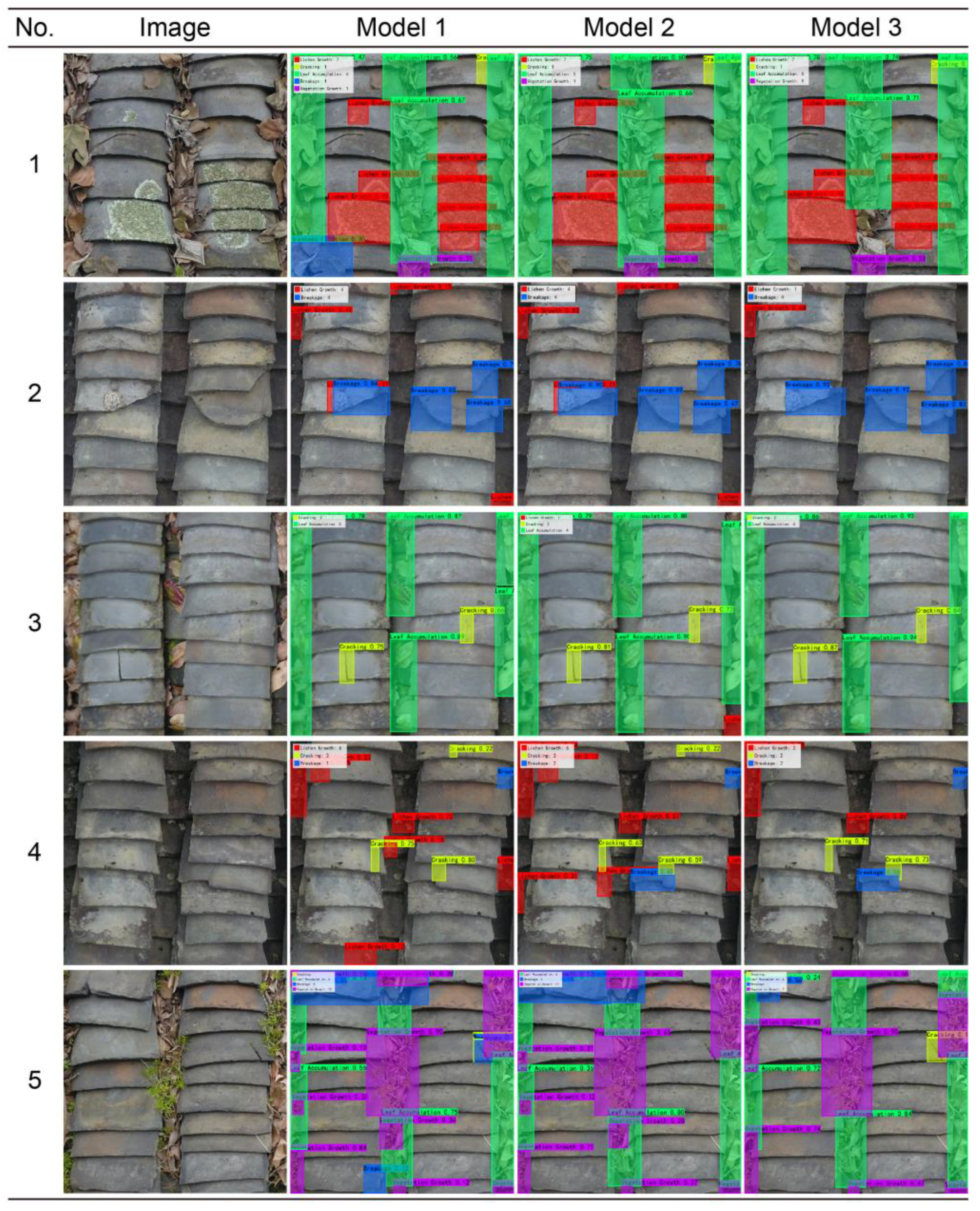
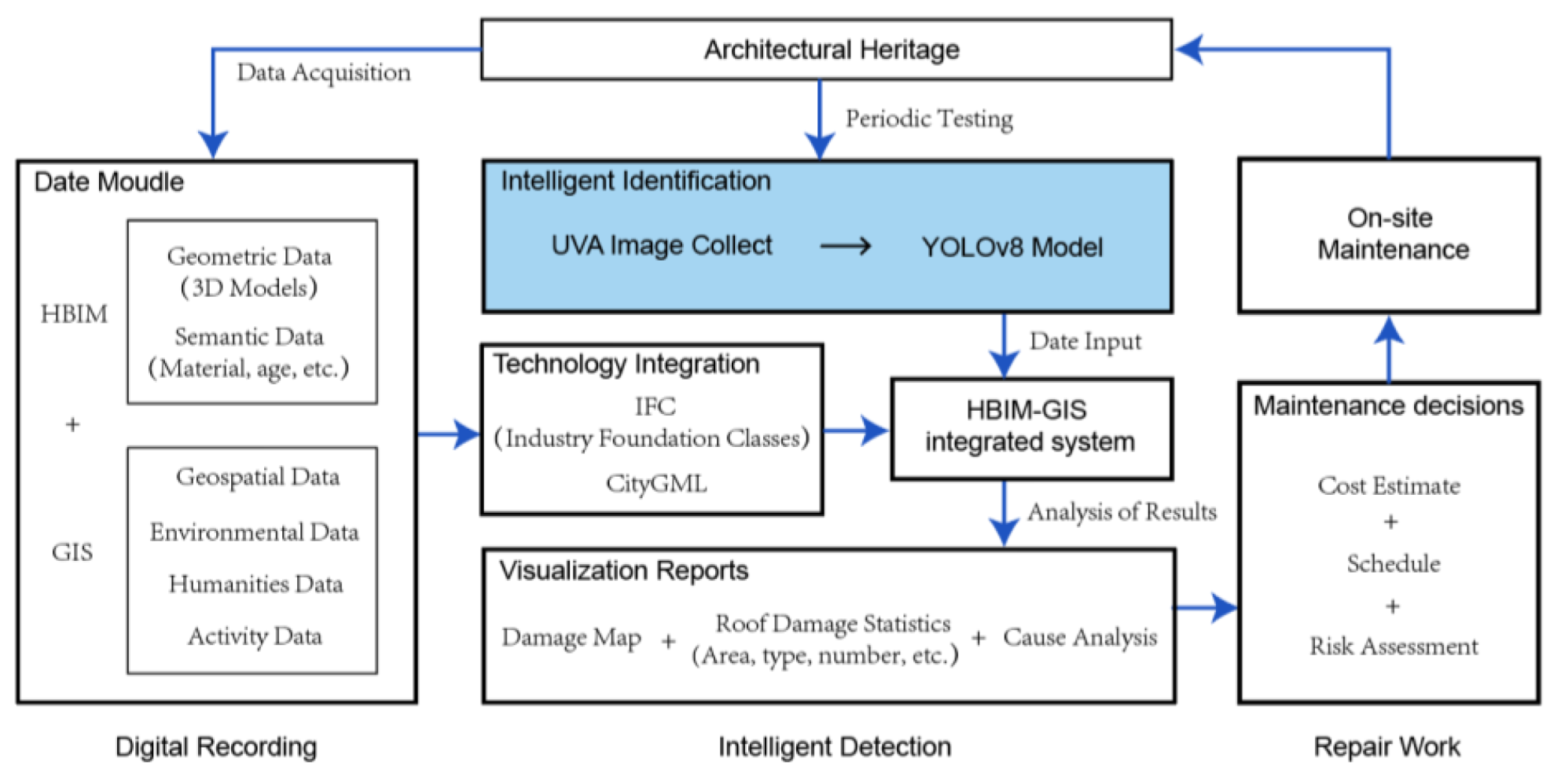
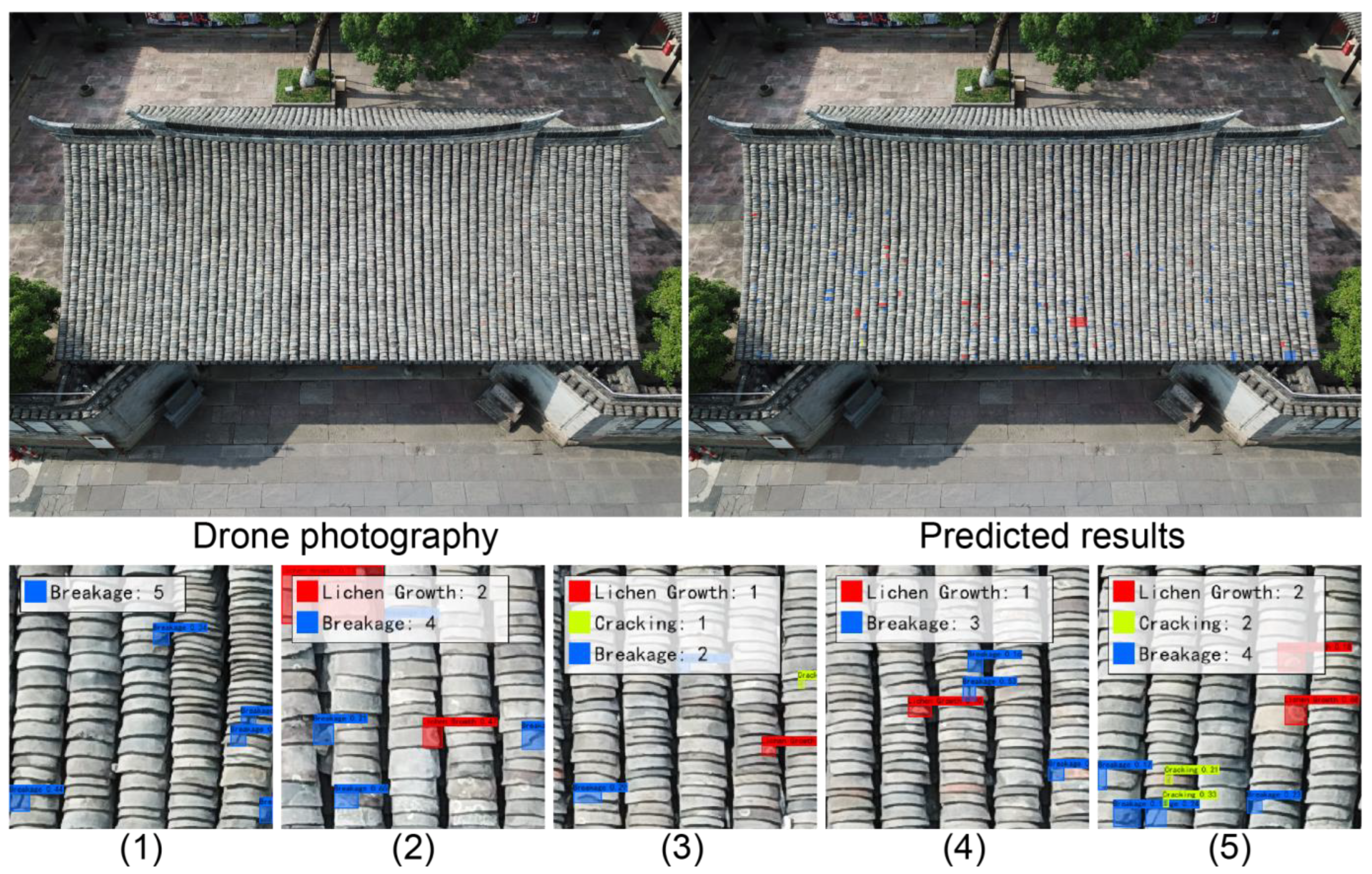
| Term | Explanation |
|---|---|
| Heatmap (in AI models) | A visual representation of model attention or feature activation across an image. Colors indicate intensity, not physical temperature. |
| mAP (Mean Average Precision) | A standard metric in object detection that evaluates the average precision across all classes, reflecting both recall and precision. |
| F1 Score | The harmonic mean of precision and recall, measuring the model’s accuracy and completeness in detecting true positives. |
| LAMR (Log-Average Miss Rate) | A metric that calculates the average miss rate across multiple thresholds, weighted logarithmically. It reflects the robustness of detection performance. |
| Confusion Matrix | A table summarizing the model’s classification results by comparing actual labels to predicted labels. Diagonal values represent correct predictions. |
| HBIM (Heritage Building Information Modeling) | A digital modeling method for documenting, managing, and preserving architectural heritage using 3D models and metadata. |
| Generalization | The ability of a trained model to perform well on new, unseen data, beyond the training dataset. |
| Overfitting | A condition where a model performs well on training data but poorly on unseen data due to excessive learning of training-specific patterns. |
| Epoch | Class | Average Precision | Log-Average Miss Rate | F1* | Precision* | Recall* |
|---|---|---|---|---|---|---|
| 60 | Breakage | 0.65 | 0.68 | 0.64 | 0.73 | 0.57 |
| Cracking | 0.79 | 0.39 | 0.72 | 0.87 | 0.6 | |
| Leaf Accumulation | 0.72 | 0.56 | 0.64 | 0.78 | 0.54 | |
| Lichen Growth | 0.73 | 0.72 | 0.68 | 0.7 | 0.66 | |
| Vegetation Growth | 0.7 | 0.65 | 0.64 | 0.68 | 0.6 | |
| 79 | Breakage | 0.68 | 0.67 | 0.69 | 0.74 | 0.65 |
| Cracking | 0.74 | 0.52 | 0.71 | 0.83 | 0.62 | |
| Leaf Accumulation | 0.74 | 0.58 | 0.69 | 0.77 | 0.62 | |
| Lichen Growth | 0.75 | 0.72 | 0.68 | 0.69 | 0.67 | |
| Vegetation Growth | 0.77 | 0.56 | 0.75 | 0.78 | 0.7 | |
| 272 | Breakage | 0.62 | 0.7 | 0.65 | 0.7 | 0.61 |
| Cracking | 0.7 | 0.52 | 0.71 | 0.8 | 0.64 | |
| Leaf Accumulation | 0.62 | 0.69 | 0.64 | 0.7 | 0.58 | |
| Lichen Growth | 0.74 | 0.59 | 0.7 | 0.72 | 0.67 | |
| Vegetation Growth | 0.73 | 0.65 | 0.7 | 0.7 | 0.68 |
Disclaimer/Publisher’s Note: The statements, opinions and data contained in all publications are solely those of the individual author(s) and contributor(s) and not of MDPI and/or the editor(s). MDPI and/or the editor(s) disclaim responsibility for any injury to people or property resulting from any ideas, methods, instructions or products referred to in the content. |
© 2025 by the authors. Licensee MDPI, Basel, Switzerland. This article is an open access article distributed under the terms and conditions of the Creative Commons Attribution (CC BY) license (https://creativecommons.org/licenses/by/4.0/).
Share and Cite
Song, H.; Chen, Y.; Zheng, L. The Non-Destructive Testing of Architectural Heritage Surfaces via Machine Learning: A Case Study of Flat Tiles in the Jiangnan Region. Coatings 2025, 15, 761. https://doi.org/10.3390/coatings15070761
Song H, Chen Y, Zheng L. The Non-Destructive Testing of Architectural Heritage Surfaces via Machine Learning: A Case Study of Flat Tiles in the Jiangnan Region. Coatings. 2025; 15(7):761. https://doi.org/10.3390/coatings15070761
Chicago/Turabian StyleSong, Haina, Yile Chen, and Liang Zheng. 2025. "The Non-Destructive Testing of Architectural Heritage Surfaces via Machine Learning: A Case Study of Flat Tiles in the Jiangnan Region" Coatings 15, no. 7: 761. https://doi.org/10.3390/coatings15070761
APA StyleSong, H., Chen, Y., & Zheng, L. (2025). The Non-Destructive Testing of Architectural Heritage Surfaces via Machine Learning: A Case Study of Flat Tiles in the Jiangnan Region. Coatings, 15(7), 761. https://doi.org/10.3390/coatings15070761








